A distinct tumor microenvironment makes anaplastic thyroid cancer more lethal but immunotherapy sensitive than papillary thyroid cancer
- PMID: 38478516
- PMCID: PMC11141884
- DOI: 10.1172/jci.insight.173712
A distinct tumor microenvironment makes anaplastic thyroid cancer more lethal but immunotherapy sensitive than papillary thyroid cancer
Abstract
Both anaplastic thyroid cancer (ATC) and papillary thyroid cancer (PTC) originate from thyroid follicular epithelial cells, but ATC has a significantly worse prognosis and shows resistance to conventional therapies. However, clinical trials found that immunotherapy works better in ATC than late-stage PTC. Here, we used single-cell RNA sequencing (scRNA-Seq) to generate a single-cell atlas of thyroid cancer. Differences in ATC and PTC tumor microenvironment components (including malignant cells, stromal cells, and immune cells) leading to the polarized prognoses were identified. Intriguingly, we found that CXCL13+ T lymphocytes were enriched in ATC samples and might promote the development of early tertiary lymphoid structure (TLS). Last, murine experiments and scRNA-Seq analysis of a treated patient's tumor demonstrated that famitinib plus anti-PD-1 antibody could advance TLS in thyroid cancer. We displayed the cellular landscape of ATC and PTC, finding that CXCL13+ T cells and early TLS might make ATC more sensitive to immunotherapy.
Keywords: Immunotherapy; Oncology; Thyroid disease.
Figures
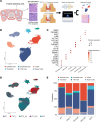
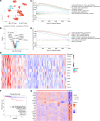
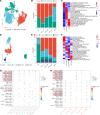



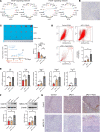
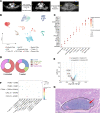
Similar articles
-
Persistent pre-exhausted CD8+ T cells shape the tumor immune microenvironment in anaplastic thyroid cancer.Endocr Relat Cancer. 2025 Jan 21;32(3):e240169. doi: 10.1530/ERC-24-0169. Print 2025 Mar 1. Endocr Relat Cancer. 2025. PMID: 39752183
-
METTL3 inhibition induced by M2 macrophage-derived extracellular vesicles drives anti-PD-1 therapy resistance via M6A-CD70-mediated immune suppression in thyroid cancer.Cell Death Differ. 2023 Oct;30(10):2265-2279. doi: 10.1038/s41418-023-01217-x. Epub 2023 Aug 30. Cell Death Differ. 2023. PMID: 37648786 Free PMC article.
-
Targeting SIGLEC15 as an emerging immunotherapy for anaplastic thyroid cancer.Int Immunopharmacol. 2024 May 30;133:112102. doi: 10.1016/j.intimp.2024.112102. Epub 2024 Apr 22. Int Immunopharmacol. 2024. PMID: 38652971
-
Immune microenvironment in papillary thyroid carcinoma: roles of immune cells and checkpoints in disease progression and therapeutic implications.Front Immunol. 2024 Sep 3;15:1438235. doi: 10.3389/fimmu.2024.1438235. eCollection 2024. Front Immunol. 2024. PMID: 39290709 Free PMC article. Review.
-
Immune Landscape of Thyroid Cancers: New Insights.Front Endocrinol (Lausanne). 2021 Apr 27;11:637826. doi: 10.3389/fendo.2020.637826. eCollection 2020. Front Endocrinol (Lausanne). 2021. PMID: 33986723 Free PMC article. Review.
Cited by
-
New Horizons of Biomarkers in Metastatic Thyroid Cancer.J Cancer. 2025 Jan 1;16(1):241-264. doi: 10.7150/jca.101395. eCollection 2025. J Cancer. 2025. PMID: 39744583 Free PMC article. Review.
-
Anaplastic thyroid cancer: Genetic roles, targeted therapy, and immunotherapy.Genes Dis. 2024 Aug 30;12(4):101403. doi: 10.1016/j.gendis.2024.101403. eCollection 2025 Jul. Genes Dis. 2024. PMID: 40271195 Free PMC article. Review.
-
Thyroid Cancer: Epidemiology, Classification, Risk Factors, Diagnostic and Prognostic Markers, and Current Treatment Strategies.Int J Mol Sci. 2025 May 28;26(11):5173. doi: 10.3390/ijms26115173. Int J Mol Sci. 2025. PMID: 40507982 Free PMC article. Review.
-
Identification of prognostic genes related to T cell proliferation in papillary thyroid cancer based on single-cell RNA sequencing and bulk RNA sequencing data.Clin Exp Med. 2025 Aug 2;25(1):273. doi: 10.1007/s10238-025-01826-5. Clin Exp Med. 2025. PMID: 40753315 Free PMC article.
-
Multiple mechanisms and applications of tertiary lymphoid structures and immune checkpoint blockade.J Exp Clin Cancer Res. 2025 Mar 5;44(1):84. doi: 10.1186/s13046-025-03318-6. J Exp Clin Cancer Res. 2025. PMID: 40038799 Free PMC article. Review.
References
Publication types
MeSH terms
Substances
LinkOut - more resources
Full Text Sources
Medical
Research Materials

